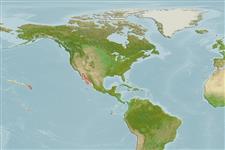>
Ophidiiformes (Cusk eels) >
Dinematichthyidae (Viviparous brotula)
Etymology: Ogilbia: Taken from Ogilby, 1887-1915, icthiologist and zoologist (Ref. 45335); davidsmithi: Named for David Smith, USNM.
Eponymy: James Douglas Ogilby (1853–1925) was an Irish-born Australian ichthyologist and taxonomist, son of the famous zoologist William Ogilby (below). [...] Dr David G Smith is an American ichthyologist who is a Museum Specialist at the Smithsonian Institution. [...] (Ref. 128868), visit book page.
More on authors: Møller, Schwarzhans & Nielsen.
Environment: milieu / climate zone / djupintervall / distribution range
Ekologi
marina bottenlevande; djupintervall 0 - 30 m (Ref. 57883). Tropical
Eastern Pacific: Gulf of California.
Size / Vikt / Age
Könsmognad: Lm ? range ? - ? cm
Max length : 9.9 cm SL hane/ej könsbestämd; (Ref. 57883)
Short description
Bestämningsnycklar | Morfologi | Morfometri
Mjukstrålar i ryggfenan (totalt) : 66 - 76; Mjukstrålar i analfenan: 50 - 61; Ryggkotor: 40 - 44. The species is distinguished by the following: vertebrae 10-13 + 29-32 = 40-44, dorsal fin rays 66-76, anal fin rays 50-61, outer pseudoclasper spinelike with two distinct supporters, anterior being 1/2 length of posterior, posterior extruding; inner pseudoclasper slender consisting mainly of supporter which is about length of anterior supporter of outer pseudoclasper, directed backward; penis with abrupt change from a thick base to a thin outer part; opercular spine with a single, sharp tip; narrow scale patch on cheeks with 5-10 vertical scale rows; otolith very slender (length: height ratio 2.4-2.6); posterior mandibular pores are large (Ref. 57883).
Collected over sand, weed, and coral or rocky bottom; including tide pools. A 55 mm SL female (USNM 322029) specimen contained about 150 eggs about 0.5 mm in diameter and 19 embryos, 6-8 mm TL, with two rows of 9-11 small pigment spots along dorsal and anal fin bases (Ref. 57883).
Life cycle and mating behavior
Könsmognad | Reproduktion | Lek | Ägg | Fecundity | Larver
Møller, P.R., W. Schwarzhans and J.G. Nielsen, 2005. Review of the American Dinematichthyini (Teleostei: Bythitidae). Part II. Ogilbia. aqua, J. Ichthyol. Aquat. Biol. 10(4):133-207. (Ref. 57883)
IUCN Red List Status (Ref. 130435: Version 2025-1)
Threat to humans
Harmless
Human uses
Verktyg
Special reports
Download XML
Internet-källor
Estimates based on models
Preferred temperature (Ref.
123201): 22.3 - 28, mean 25 °C (based on 141 cells).
Phylogenetic diversity index (Ref.
82804): PD
50 = 0.5000 [Uniqueness, from 0.5 = low to 2.0 = high].
Bayesian length-weight: a=0.00389 (0.00180 - 0.00842), b=3.12 (2.94 - 3.30), in cm total length, based on all LWR estimates for this body shape (Ref.
93245).
Trofisk nivå (Ref.
69278): 3.4 ±0.5 se; based on size and trophs of closest relatives
Fishing Vulnerability (Ref.
59153): Low vulnerability (10 of 100).
🛈
